EASY
Earn 100
If the length of a potentiometer wire is increased by keeping constant potential difference across the wire, then _____.
(a)Null point is obtained at larger distance.
(b)There is no change in the null point.
(c)Potential gradient is increased.
(d)Null point is obtained at shorter distance
50% studentsanswered this correctly
Important Questions on Current Electricity
HARD
The balancing length for a cell is in a potentiometer experiment. When an external resistance of is connected in parallel to the cell, the balancing length changes by . If the internal resistance of the cell is , where n is an integer then value of n is ________
HARD
A potentiometer wire, long, has a resistance of It is connected in series with a resistance box and a storage cell. If the potential gradient along the wire should be , the resistance unplugged in the box is
HARD
In a potentiometer experiment, it is found that no current passes through the galvanometer when the terminals of the cell are connected across 52 cm of the potentiometer wire. If the cell is shunted by a resistance of ,a balance is found when the cell is connected across 40 cm of the wire. Find the internal resistance of the cell.
EASY
is a wire of potentiometer with the increase in the value of resistance , the shift in the balance point will be
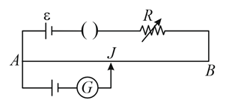
MEDIUM
An ideal battery of emf and resistance are connected in series in the primary circuit of a potentiometer of length and resistance The value of to give a potential difference of across of potentiometer wire, is:
EASY
A potentiometer circuit has been set up for finding the internal resistance of a given cell. The main battery, used across the potentiometer wire, has an emf of and a negligible internal resistance. The potentiometer wire itself is long. When the resistance, connected across the given cell, has values of.
infinity
The 'balancing lengths, on the potentiometer wire are found to be and respectively. The value of internal resistance of the cell is:
EASY
A potentiometer is an accurate and versatile device to make electrical measurements of E.M.F, because the method involves:
MEDIUM
A potentiometer has a uniform wire of length A battery of emf and negligible internal resistance is connected between its ends. A secondary cell connected to the circuit gives balancing length at . The emf of the secondary cell is
HARD
A potentiometer wire of length and a resistance are connected in series with a battery of e.m.f. and a resistance . An unknown e.m.f. is balanced at a length of the potentiometer wire. The e.m.f. will be given by:
EASY
A potentiometer wire has length and resistance . The resistance that must be connected in series with the wire and an accumulator of e.m.f. , so as to get a potential gradient per cm on the wire is :
HARD
The length of a potentiometer wire is and it carries a current of For a cell of and internal resistance of the null point on it is found to be at The resistance of whole wire is:
EASY
A potentiometer wire is long and a constant potential difference is maintained across it. Two cells are connected in series first to support one another and then in opposite direction. The balance points are obtained at and from the positive end of the wire in the two cases. The ratio of EMF's is :
MEDIUM
In a potentiometer experiment, the balancing point with a cell is at a length . On shunting the cell with a resistance of , the balancing length becomes . The internal resistance of the cell is
EASY
In the circuit shown, a four-wire potentiometer is made of a long wire, which extends between and . The resistance per unit length of the potentiometer wire is If an ideal voltmeter is connected as shown with jockey at from end , the expected reading of the voltmeter will be:
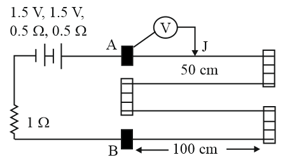
EASY
A potentiometer wire of length is connected to a standard cell . Another cell of emf is connected with a resistance and switch (as shown in figure). With switch open, the null position is obtained at a distance of from . The potential gradient in the potentiometer wire is :
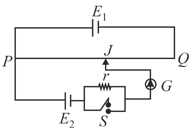
EASY
The length of a potentiometer wire is A cell of e.m.f. is balanced at a length from the positive end of the wire. If the length of the wire is increased by , at what distance will the same cell give a balance point?
HARD
If the balancing length in a potentiometer experiment changes by when the cell of unknown emf is shunted by resistance, then the internal resistance of the cell in is
MEDIUM
A potentiometer is set up to compare two resistances, as shown in the figure. The ammeter in the circuit reads when the two-way key is open. The balance point is at a length from when the two-way key is plugged in between , while the balance point is at a length from when the key is plugged in between . The ratio of two resistances is found to be
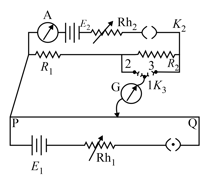
MEDIUM
A potentiometer wire having length and resistance is joined to a cell of emf and internal resistance . A cell having EMF and internal resistance is connected. The length , at which the galvanometer, as shown in the figure, shows no deflection is
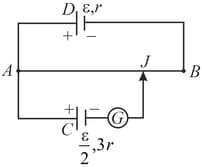
EASY
Potentiometer wire of length is connected in series with resistance and battery. If is the potential gradient, then resistance of the potentiometer wire is

